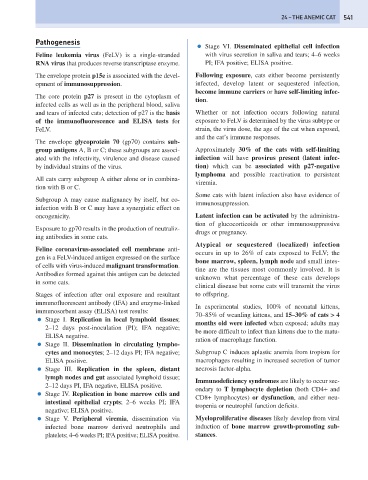Page 549 - Problem-Based Feline Medicine
P. 549
24 – THE ANEMIC CAT 541
Pathogenesis
● Stage VI. Disseminated epithelial cell infection
Feline leukemia virus (FeLV) is a single-stranded with virus secretion in saliva and tears; 4–6 weeks
RNA virus that produces reverse transcriptase enzyme. PI; IFA positive; ELISA positive.
The envelope protein p15e is associated with the devel- Following exposure, cats either become persistently
opment of immunosuppression. infected, develop latent or sequestered infection,
become immune carriers or have self-limiting infec-
The core protein p27 is present in the cytoplasm of
tion.
infected cells as well as in the peripheral blood, saliva
and tears of infected cats; detection of p27 is the basis Whether or not infection occurs following natural
of the immunofluorescence and ELISA tests for exposure to FeLV is determined by the virus subtype or
FeLV. strain, the virus dose, the age of the cat when exposed,
and the cat’s immune responses.
The envelope glycoprotein 70 (gp70) contains sub-
group antigens A, B or C; these subgroups are associ- Approximately 30% of the cats with self-limiting
ated with the infectivity, virulence and disease caused infection will have provirus present (latent infec-
by individual strains of the virus. tion) which can be associated with p27-negative
lymphoma and possible reactivation to persistent
All cats carry subgroup A either alone or in combina-
viremia.
tion with B or C.
Some cats with latent infection also have evidence of
Subgroup A may cause malignancy by itself, but co-
immunosuppression.
infection with B or C may have a synergistic effect on
oncogenicity. Latent infection can be activated by the administra-
tion of glucocorticoids or other immunosuppressive
Exposure to gp70 results in the production of neutraliz-
drugs or pregnancy.
ing antibodies in some cats.
Atypical or sequestered (localized) infection
Feline coronavirus-associated cell membrane anti-
occurs in up to 26% of cats exposed to FeLV; the
gen is a FeLV-induced antigen expressed on the surface
bone marrow, spleen, lymph node and small intes-
of cells with virus-induced malignant transformation.
tine are the tissues most commonly involved. It is
Antibodies formed against this antigen can be detected
unknown what percentage of these cats develops
in some cats.
clinical disease but some cats will transmit the virus
Stages of infection after oral exposure and resultant to offspring.
immunofluorescent antibody (IFA) and enzyme-linked
In experimental studies, 100% of neonatal kittens,
immunosorbent assay (ELISA) test results:
70–85% of weanling kittens, and 15–30% of cats > 4
● Stage I. Replication in local lymphoid tissues;
months old were infected when exposed; adults may
2–12 days post-inoculation (PI); IFA negative;
be more difficult to infect than kittens due to the matu-
ELISA negative.
ration of macrophage function.
● Stage II. Dissemination in circulating lympho-
cytes and monocytes; 2–12 days PI; IFA negative; Subgroup C induces aplastic anemia from tropism for
ELISA positive. macrophages resulting in increased secretion of tumor
● Stage III. Replication in the spleen, distant necrosis factor-alpha.
lymph nodes and gut associated lymphoid tissue;
Immunodeficiency syndromes are likely to occur sec-
2–12 days PI, IFA negative, ELISA positive.
ondary to T lymphocyte depletion (both CD4+ and
● Stage IV. Replication in bone marrow cells and
CD8+ lymphocytes) or dysfunction, and either neu-
intestinal epithelial crypts; 2–6 weeks PI; IFA
tropenia or neutrophil function deficits.
negative; ELISA positive.
● Stage V. Peripheral viremia, dissemination via Myeloproliferative diseases likely develop from viral
infected bone marrow derived neutrophils and induction of bone marrow growth-promoting sub-
platelets; 4–6 weeks PI; IFA positive; ELISA positive. stances.

